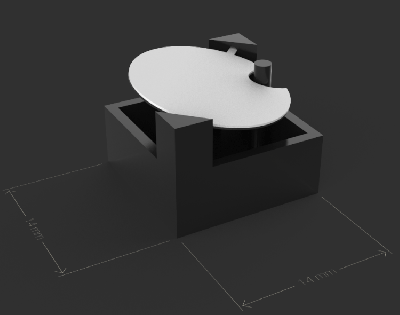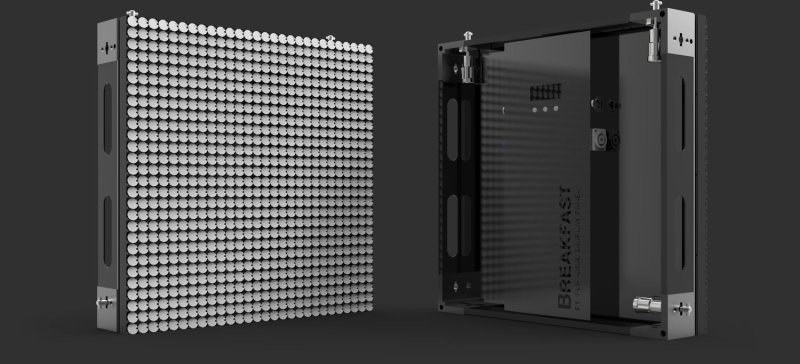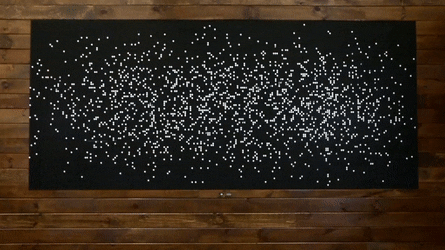Admit it, you’ve always wanted to have your own flip-dot display to play with. Along with split-flap displays, flip-dots have an addictive look and sound that hearkens back half a century but still feels like modern technology. They use a magnetic coil to actuate each pixel — physical discs painted contrasting colors on either side. It means that you really only need electricity when changing the pixel, and that each pixel makes a satisfyingly unobtrusive click when flipped. The only problem with the displays is that they’re notoriously difficult to get your hands on.
 Breakfast, a Brooklyn-based hardware firm known for creative marketing installations, unveiled their Flip-Disc Display System this morning. Used displays have come up on the usual sites from time to time, but often without a controller. Traditional flip-dot manufacturers haven’t sought out the individual hacker or hackerspace, and a click-to-buy option has been difficult if not impossible to find.
Breakfast, a Brooklyn-based hardware firm known for creative marketing installations, unveiled their Flip-Disc Display System this morning. Used displays have come up on the usual sites from time to time, but often without a controller. Traditional flip-dot manufacturers haven’t sought out the individual hacker or hackerspace, and a click-to-buy option has been difficult if not impossible to find.
Breakfast’s offering modernizes the driver used to manage all of those electro-mechanical pixels. Whether this will make the displays more accessible is a question that still needs to be answered.
Breakfast has designed their own driver circuit for each panel of 28×28 pixels which includes a Cortex-M microcontroller. The easily daisy-chainable panels (using cat5 + power) pump up the maximum data propagation across a display by at least two orders of magnitude over traditional drivers. The demo video below shows 30 FPS being controlled by a time-of-flight camera (an ASUS Xtion in this case but that could change for production). Each panel draws about 300 mW at rest and typical full-motion operation is 25-50 W per panel but the system does have intelligent power design to cap total power draw.
Can you own one? Probably not — but that’s just because of your pocketbook. Breakfast wouldn’t give an exact price, but they did oblige when we asked for an approximation in terms of Honda Fits. Minimum order is 15 panels (140×84 pixels or about 7’x4.25′) and will run you about 6.25 Honda Fits.

Despite your not having low-six-figures lying around to spend on this, it is a notable development. The modernization of the driver, addition of an app and programming API, and a push to sell to a wider customer base should reinvigorate the occurrence of flip-dot displays which have been all but extinct this century. If there is a surge in purchases it will be many years before the secondary market benefits, but hopefully a groundswell of interest will encourage them to make the hacker-edition of their display available for a more… flippant… price.
We’ve seen a lot of work come out of Breakfast, notably this 6,400 pixel colored-thread display which is a mechanical engineering playground. When it comes to flip-dots, nothing beats what we saw at CES in 2015.

















Wow! Really cool. Would love to see a DIY version.
Yeah, I really want to know how feasible it would be to roll my own flip-dot display now.
When I last looked, a strip of 5 dots cost about 4 euro – before factoring in controllers.
Like anything else “industrial” — you want it new, you’re gonna pay through the nose for it. You want to get rid of it, you’ll have to pay someone to take it away.
I don’t know where these are used (my airport and train station use LCD monitors or LED panels), but if you find someplace that uses them, or a salvage yard, you might just walk away with one for nothing (except what you consider your scavenging hours to be worth, of course)
You’re much more likely to find a 7-segment flip digit this way. Well into the 2000’s, until modern superbright LED’s became cheap enough, flip segments were the standard for displays that have to be readable both in bright sunlight and in darkness, but for numeric data like weight or flight numbers 7 segment displays are a lot cheaper and easier to control than flip dot matrix.
Intra-city Busses (buses?) often have them to display their route. Maybe someone who works for the bus company could point you to where the busses go when they die?
I built a controller for a flip segment display in college. They really aren’t hard, and if you build the drivers for the segments right, they can be pretty inexpensive too.
It seems like an exercise in making thousands of tiny fiddly mechanical devices that have to be built precisely enough to all work approximately equally well.
Should totally be doable on a personal scale, but might be an exercise in frustration.
Some of it looks like it could be done on a 3D printer.
Making thousands, or even hundreds of ANYTHING on a 3D printer sounds like the wrong way. If the flip things can be made with just vinyl magnet, painted on both sides, then I think those could be made with a simple die, a hundred or more at a time. I’ve seen custom cardboard cutting dies sold to crafters for pretty reasonable prices. The die and media are run through a roller press, taking about a minute for however many pieces you can fit in your press. That should take care of the flip pieces. The harder part, probably, is the frame, but that too could possibly be die-cut and folded from sheet mylar maybe.
Ga! It’s got a stuck ‘pixel’! How typical!
Unlike a LCD/LED display though maybe you can fix it by tapping it? :)
Yeah, I noticed that tool. Was wondering if there’s a degaussing routine that would fix this automatically or if the pixel (actually come in 7-pixel wands) module needs to be replaced?
Playing Space Invaders on a flip dot display would be awesome!
Too bad you can’t play othello/reversi on it (needs third colour for unoccupied square)
Third color may be a little tricky to implement.
I mean you COULD, but it wouldn’t be a flip-disc, it’d be a flip-truncated-triangular-prism. And then there’s the problem of now to make a tripoloar magnet.
It would just be a highly optimized stepper motor. I can see it being done with 3 or 4 colors. once you hit 5, you’d start losing usable pixel size relative to the total pixel unit, however.
Okay, that works for three colors. You can put a stop on it so it won’t go past black one way, to give an easy way to get the whole panel to a known state.
Surely some form of multi-click mechanism could be devised.
You’d need at least half a cube to serve as the display (the support structure would be defined by space/durability requirements), alternating visible faces for the 3 colors. By having 3 control arms attached to the ‘free’ corners of the half cube you could either use 3 separate solenoids or rig up some sort of rotary cam mechanism to alternate the lengths of each control arm. You’d need 2 short and one long control arm/servo to shift through the colors.
A triangular bipyramid would also work, but you’d need many more pixels to create a coherent display.
When you need thousands of these for a display, servos aren’t going to cut it, unless you have a LOT of Honda Fits. Think simple. Look at the animation: a flip disc consists of a die-cut piece of painted sheet steel with vinyl magnet on its back, a relatively simple injection-molded frame, and inside that a coil. The coil may be center-tapped so you get row drive on the center tap, then “1” column drive on one end and “0” column drive on the other end of the coil. Three parts. That’s the goal. I think four colors can be displayed using something almost as simple, using the stepper motor idea.
What I don’t know is what makes the flip disc bistable. Oh – I see it, the cutout in the disc makes the edge without the cutout heavier than the other side so it tends to stay in the direction you flip it to. That’s harder with a four-color “disc”.
There are solutions for that: I remember Hoog Cathreine in Utrecht, Netherlands having something of 3 by 4 meters that was capable or three colours plus black, and I’m very sure that wasn’t a Jumbotron or something, but definitely mechanic. Refreshing that beast took about 30 seconds and it had a resolution of shit, but it worked somehow.
This sign?
http://www.vvv.nl/activiteitenkaart/detail/80d14d6b-789b-4b5a-96c3-b62cc907cce1
https://www.dreamstime.com/stock-photos-people-shopping-modern-shopping-centre-hoog-catharijne-utrecht-netherlands-indoor-city-image37899653
dithering, anyone? take a step back and you have grayscale.
Whoever thought it would be great to have music instead of the flipdot sound on that video thought wrong. So sad.
Same here. :(
Recently watched a video of a relay calculator, with no sound of the relays.
Oh, 2016….
Must be awfully noisy!
Are there 5.25 other Honda Fit owners who’d like to go in on a set?
Wordstar on a flipdot VT100…
And a nice steampunk keyboard!
\o/
You heared me, Santa?!?!?!?!?!!?!!!
Not all of the flip-dot displays use a magnetic field to flip the dots. The scrolling ones used puffs of air.
Really? Do you have a good demo of this somewhere, I’d love to take a look.
I can’t seem to find any examples online but I’ll keep looking. If I recall properly they were marketed under the name “Jet-aire”. They were used for stock ticker displays in the 1960s and 1970s.
They were marketed under the name “Trans-Lux Jet”.
https://www.google.com/patents/US3589672?dq=inassignee:%22Trans+Lux+Corp%22&hl=en&sa=X&ved=0ahUKEwiBu5qP0KDOAhVEFh4KHYS_DI04ChDoAQhaMAk
Pneumatic flip-flops, right? That way you only have to control one edge’s worth of dots, and supply a clock signal via air pulse.
EBAY has used 16×32 ones for $160. you could easily do this project for less than 3k with used parts and a lot of elbow grease.
Please try to be consistent with community standards and express your prices in Honda Fits.
Thank you.
That would be….
1 Honda Fit post-air bag deployment.
HA! Thanks for that laugh ;)
We actually looked at the AlfaZeta product (aka fllipdots.com, who I suspect they’re partnering with) for a project a few months ago. The 28 x 14 pixel modules (made up I think of 7×7 sub modules) ran well less than a grand each. Doing some ‘Honda Fit’ math, it looks like they’re asking for 6k – 7k each. The value add is custom colors, aluminum frames suitable for the rental & staging market, and a turn-key software approach. Some nice-to-haves for folks who can’t or don’t want to get their hands dirty, but jeez, that’s a hell of a markup.
And how many bananas high and wide?
For reference an internet standard banana is about 3/4 of a nanosecond.
Very grace-ful of you. Just throw the bananas in the hopper.
That is cool, check out this crazy contraption: https://vimeo.com/128375543
who produced this? it’s amazing!
Having spent a winter or two inside giant highway DMS boards, I despise these things. It was a hybrid flip-dot/LED board, with stuck pixels everywhere. They need to be exercised regularly to prevent mechanical failure.
Please let this tech burn in hell.
Is it warm inside there?
Were you homeless at the time?
Figure out how to add a WS2812 to the corner of each dot and shine it on the white facing side – Now you can do multicolor dots!
Brilliant and you can then also leave out the flip-dots and make it silent…
But seriously if you really want to go for color, use 3 flip-dots, one for R , G and B to make a single pixel.
It increases complexity but the pixels will be completely mechanical. Using LED’s would be cheating and we can’t have that, can we?
Open source flipdot electronics?
http://wiki.muc.ccc.de/flipdot:start
https://github.com/muccc/flipdots
https://www.youtube.com/watch?v=mN7yumsafPY
https://metalab.at/wiki/Flipdots
Those panels used to be a highway traffic announcement display.
I’m holding out for a flip-dodecahedron display.
I’m told that Coca-Cola have a huge installation of red/white flip-dot walls in their HQ, a veritable shit-tonne of Honda Fits
Looks like scaled up digital micromirror devices (DMD) used in DLP projection : https://www.youtube.com/watch?v=sBwfEWRkpoA
Neat.
Muuuuuch cooler demo: https://www.youtube.com/watch?v=7oSH-aZKyU8